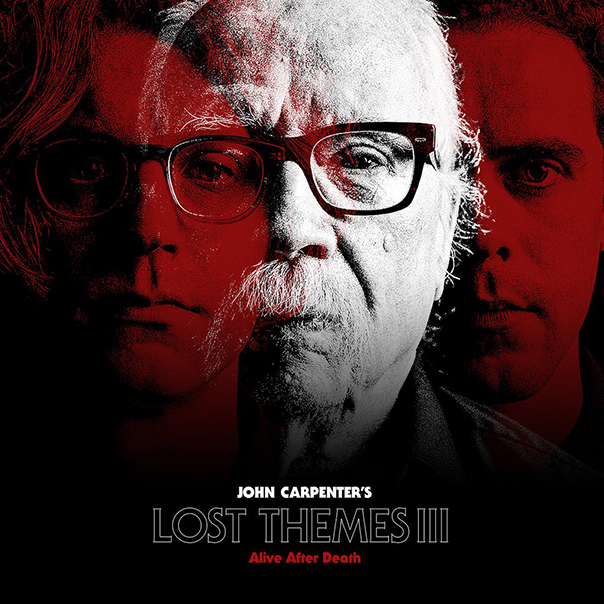REVIEW: John Carpenter strikes again on ‘Lost Themes III: Alive After Death’

Lost Themes III: Alive After Death is the third in a series of what you might call John Carpenter soundtracks to the films he never made. After decades of scoring his own movies, giving him a rare kind of control over the ambience and tone of his films, Carpenter turned to exploring his signature synth sounds free of the constraints of cinematic scoring.
Lost Themes III: Alive After Death
John Carpenter
Sacred Bones, Feb. 5
7/10
This is also a story of collaboration, between John Carpenter and his younger musical associates—son Cody Carpenter and godson Daniel Davies—and also between the trio and record label Sacred Bones, whose approach to advancing both new and older artists with its own distinctive aesthetic stamp is both innovative and a welcome throwback to the heyday of independent record labels with strong opinions and personality.
Aside from how good of a listen the album in its own right, the question with Lost Themes III is whether this collaboration holds up relative to the prior two albums in this series and as a part of the whole sonic oeuvre of John Carpenter. The good news is, this third entry in the series is as solid as the previous two. Unfortunately, there will be few surprises for fans of volumes I and II.
Working in a style Carpenter has developed over decades—literally over the course of modern electronic music, which he helped to shape and to influence—is what you expect. When Carpenter reminds you of say, Stranger Things, it’s because that sound started with him. Few artists can get as great an effect from the minimalist synth lines, simple melodies and haunting arpeggios as he does. It’s as much about what isn’t there as what is; the pauses and pacing, the turns in mood that suggest the cinematic.
Fitting for a time when we are facing so much loss, Lost Themes III’s strongest moments are its most moody and meditative. These moments exist on the first two Lost Themes albums (“White Pulse” on Lost Themes II and “Wraith” on Lost Themes I). But where especially on the first album the high points were the most energetic and driving, on this release the quieter and slower tracks speak louder.
“Dripping Blood,” despite the gory name, evokes absence more than violence—and, is one of the prettiest tunes John Carpenter and company have created, with hints of Angelo Badalamenti’s Twin Peaks music. “Dead Eyes,” as well, continues this Badalamentian vein with an eerie and melancholy mood reminiscent of “City of Lost Children,” with a worldly sadness that shines through the synthetic chimes.
Not that there aren’t plenty of pounding beats and pulsing bass here. Opener “Alive After Death” starts in classic Carpenter fashion with a simple minor-key synth sequence transitioning to sweeping, ominous bass and adding the kind of minimalist percussion we know so well from the “Halloween” films. “Skeleton” also balances a heavy dance beat with layered movie-house synth strings, bright and forward-looking chords with a noir sound aesthetic.
“Turning the Bones” is a more purely tonal synth exploration, with repetitive sequences whose small variations and layers mount hypnotically. This track feels more “Blade Runner”-adjacent, like it would fit a dark sci-fi cityscape, with the sad-toy melancholy of busy textures similar to early Depeche Mode. “Cemetary” strikes a fresh combination of elements for the group with a variety of percussive sounds and driving rhythms in the foreground, melodic synths weaving in the background. Creepy soundscapes and dissonant synths enter in the latter half, maintaining mounting suspense.
There are some lesser moments on the album, with some signs that ideas are getting recycled. The guitar solo on “Alive After Death” is almost too dead-on ’80s style to take in earnest—but is also, pitch-perfect for what it is. “Vampires Touch” and “The Dead Walk” have some successful elements but don’t quite have anything to make them stand out. On the latter track, as in a few places on the album, there’s an excess of synthetic choral sounds that are best used sparingly. And “Carpathian Darkness,” with a name that sounds like the black metal songs whose instrumental interludes often resemble the songs on Lost Themes, closes the album with a forgettable five-minute meander.
Lost Themes III could have afforded room for some of the cool experimentation found on the remixes–more dissonance, more noise, some weirder and sharper sounds. I had to imagine the possibilities of collaborations with younger artists working in similar styles who might be interested, as well as Sacred Bones labelmates or past remixers like Blanck Mass and Jim Thirlwell.
All that said, this album is still every bit a worthy entry to Carpenter’s body of work and his musical trio’s series of free-floating film music. At its best, it’s sublime—in the old capital-R Romantic sense of the word, as a feeling akin to terror, and inseparable from it—an experience of awe and of the alien. It’s a feeling his movies aim for, too, and achieved often enough in spite of slim budgets and genre conventions to make John Carpenter a hero to countless filmmakers.
Listening to music, we’re scoring our lives. The moments of loss and pathos, as well as the moments of resilience and hard-won hope on Lost Themes III: Alive After Death are fitting at a moment when COVID-19 has taken so many lives and continues to rage.
Follow reporter Justin Allen at Twitter.com/_justinallen_ and justinallen.us.
